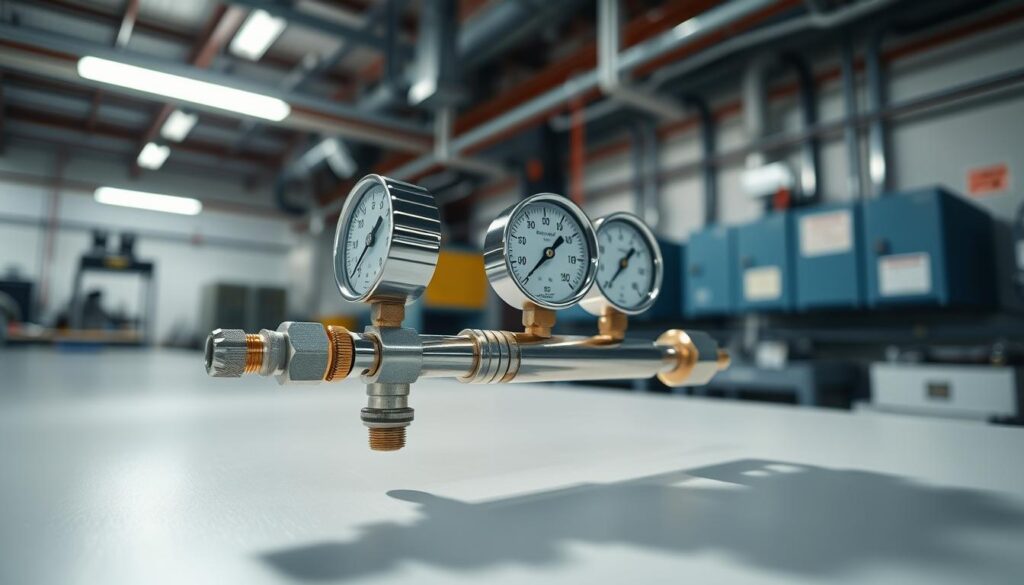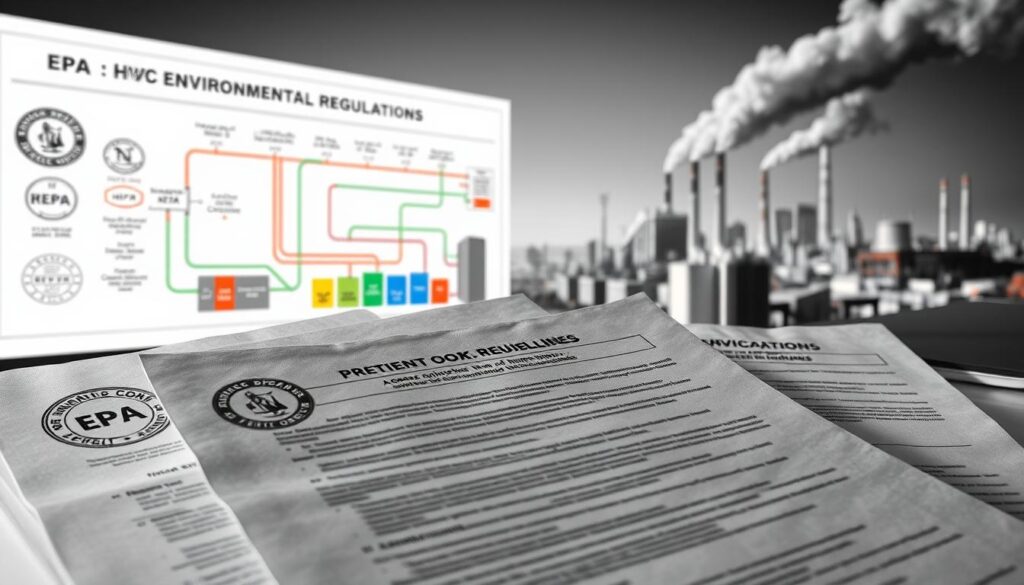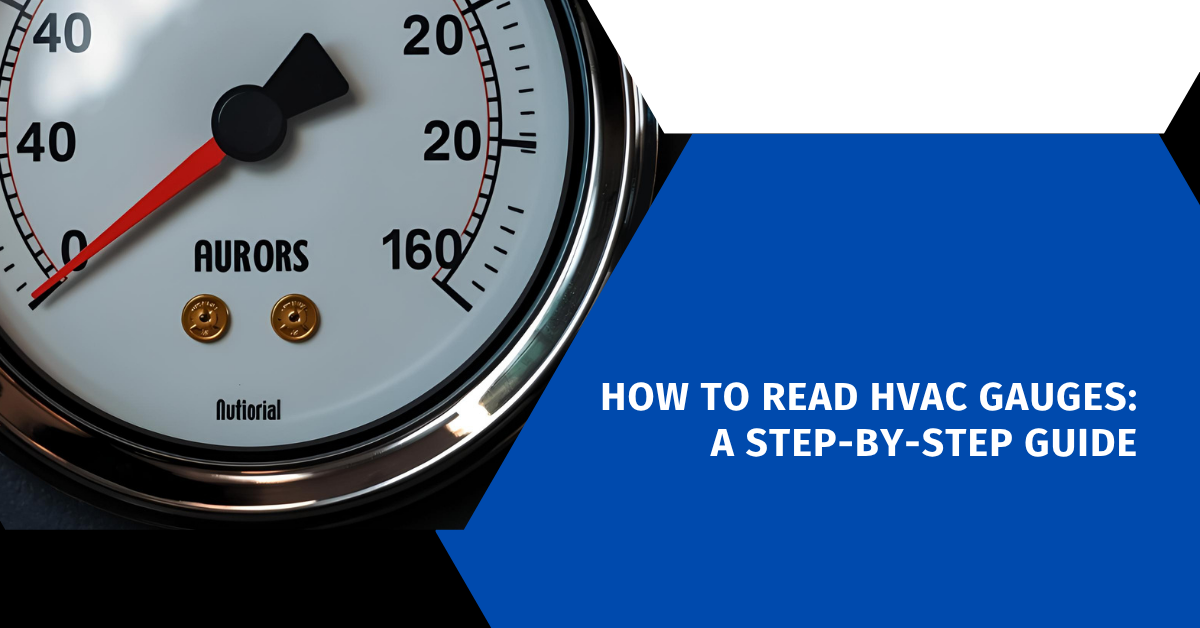Affiliate Disclosure
HVAC Guide Guys is a participant in the Amazon Services LLC Associates Program, an affiliate advertising program designed to provide a means for sites to earn advertising fees by advertising and linking to Amazon.
How to Read HVAC Gauges? Ever wondered what your HVAC system’s pressure gauges are hiding? Learning to read these gauges can make you a pro at fixing and keeping your cooling and heating systems running smoothly.

An HVAC manifold gauge set is more than just a bunch of dials and hoses. It’s a key tool for diagnosing your system’s health, showing real-time performance, refrigerant levels, and any problems. Experts use these gauges to keep systems running well and avoid expensive repairs.
It’s not just for pros. Homeowners and DIY fans can learn to check their system’s health. This can save you time and money by avoiding unnecessary service calls.
Key Takeaways
- HVAC gauges provide crucial system performance information
- Understanding gauge readings helps prevent potential system failures
- Proper gauge interpretation requires knowledge of pressure and temperature relationships
- Regular gauge monitoring can extend HVAC system lifespan
- Professional training enhances gauge reading accuracy
Table of Contents
Understanding HVAC Gauge Components and Types
Working with heating, ventilation, and air conditioning systems requires knowing your hvac manifold gauge set. It’s key for accurate diagnostics and maintenance. These tools help technicians measure system performance and spot issues fast.
Professional HVAC technicians use advanced tools for system insights. Your gauge set is more than a simple tool. It’s a detailed diagnostic instrument.
Key Components of Manifold Gauge Sets
- Two primary pressure gauges (high and low side)
- Three specialized valves for system management
- Color-coded refrigerant hoses
- Connecting adapters and fittings
Digital vs. Analog Gauge Technologies
Modern HVAC pros have two main gauge options: digital and analog. Each has its own benefits for diagnostics.
| Gauge Type | Precision | Cost | Typical Use |
|---|---|---|---|
| Digital Gauges | High | Expensive | Advanced diagnostics |
| Analog Gauges | Standard | Affordable | Basic maintenance |
Understanding Air Conditioning Gauge Colors
Your hvac manifold gauge set uses specific colors for quick identification and connection:
- Red Hose: High-pressure side connection
- Blue Hose: Low-pressure side connection
- Yellow Hose: Refrigerant charging line
Knowing these colors prevents system damage and ensures safe refrigerant handling.
Explore Our HVAC Shop
Looking for top-rated HVAC tools, parts, and accessories? Visit our shop and find the perfect solution for your needs.
Visit the ShopSafety Precautions and Initial Setup
When you’re working with HVAC gauges, safety comes first. Getting accurate refrigerant pressure readings is crucial. You need to take the right steps to avoid any dangers.
Before you start checking your HVAC system, get the right safety gear:
- Chemical-resistance safety glasses
- Thick protective gloves
- Long-sleeve protective clothing
- Closed-toe work boots
Setting up your workspace is key for safe refrigerant pressure readings. Make sure you’re in a place with good air flow, enough light, and no chance of refrigerant spills.
Professional HVAC technicians always prioritize personal safety and environmental protection during system diagnostics.
Here are some important safety steps for HVAC troubleshooting with gauges:
- Make sure you’re EPA certified for refrigerant handling
- Check all equipment for damage
- Ensure gauge connections are tight
- Use the right equipment for refrigerant recovery
Remember, wrong handling can cause big environmental problems and legal issues. Always stick to the manufacturer’s instructions and local laws when working with HVAC systems and refrigerant pressure readings.
How to Read HVAC Gauges
Learning to read HVAC gauges is key for fixing and keeping air conditioning systems running well. HVAC pros use these readings to check how the system is doing and find problems.
To read HVAC gauges, focus on two main things: high side and low side pressure. These numbers tell you a lot about how the refrigeration cycle is working and if the system is healthy.
Reading Low-Side Pressure Gauge
The low-side gauge shows suction pressure, which tells you about the refrigerant before it goes into the compressor. Important things to look for when reading the low-side gauge include:
- Checking pressure range typically between 0-250 PSI
- Understanding vacuum measurements down to 30 inches of mercury
- Identifying normal operating pressure for specific refrigerant types
Reading High-Side Pressure Gauge
High side gauges track discharge pressure, showing what’s happening after the system works. When looking at high side and low side pressure, remember these important points:
- Measuring discharge pressure from 0-800 PSI
- Evaluating system performance under different ambient temperatures
- Detecting potential blockages or compressor inefficiencies
Understanding Pressure-Temperature Relationships
The relationship between pressure and temperature is crucial in HVAC systems. To read gauges right, you need to get this:
| Refrigerant Type | Low-Side Pressure | High-Side Pressure |
|---|---|---|
| R-22 | 60-70 PSI | 250-300 PSI |
| R-410A | 110-130 PSI | 300-400 PSI |
Pro tip: Always compare gauge readings with manufacturer specifications to ensure accurate system diagnosis.
Explore Our HVAC Shop
Looking for top-rated HVAC tools, parts, and accessories? Visit our shop and find the perfect solution for your needs.
Visit the ShopConnecting Gauges to HVAC System
Connecting your hvac manifold gauge set correctly is key for getting precise refrigerant pressure readings. You need to be precise and pay close attention to detail. This ensures safe and effective system checks.

- Hvac manifold gauge set
- Protective gloves
- Safety glasses
- Clean cloth or rag
Here’s how to connect your gauges safely:
- Find the service ports on your HVAC system
- Clean the service port connections
- Spot the low-pressure (blue) and high-pressure (red) ports
- Securely attach hoses with low-loss fittings
When you connect the gauge set, make sure it’s sealed tight. The blue hose goes to the low-pressure service port (the bigger port on the suction line). The red hose connects to the high-pressure port (the smaller port on the liquid line).
| Hose Color | Port Type | Connection Location |
|---|---|---|
| Blue | Low-Pressure | Suction Line |
| Red | High-Pressure | Liquid Line |
Modern low-loss fittings click when they’re in place right, stopping refrigerant spray. Listen for this click to know it’s secure. Be careful to avoid refrigerant loss and keep the system safe during connection.
Pro Tip: Always wear protective equipment and work in a well-ventilated area when handling HVAC systems.
Understanding Pressure and Temperature Readings
Working with air conditioning systems means knowing about refrigerant pressure readings. Your AC system’s pressure chart is key to its health and efficiency.
Reading ac pressure chart data correctly helps find system problems early. Refrigerant pressure readings are a crucial tool for HVAC experts and homeowners.
Normal Operating Ranges
Each refrigerant system has its own pressure range for working right. For R-410A systems, here are the usual numbers:
- Low-side pressure: 60-85 PSI
- High-side pressure: 300-400 PSI
- Ambient temperature impact: Pressure changes with outside conditions
Identifying Abnormal Readings
Spotting odd refrigerant pressure readings can stop big system problems. Look out for these signs:
- Pressure that’s more than 10 PSI off from what’s recommended
- Big temperature-pressure mismatches
- Readings that stay outside the usual range
Temperature-Pressure Correlation
Your AC system’s performance relies on the right temperature and pressure mix. A 10 PSI difference can cut system efficiency by 5-7%. So, keeping an eye on it is key for top performance.
Knowing these fine details helps with early maintenance and saves money.
Measuring Superheat and Subcooling
Understanding your HVAC system’s performance is key. Superheat and subcooling measurements are crucial. They show how well your refrigerant system works and if it’s charged right.
Superheat and subcooling help find system problems. They show how well your refrigeration system is doing:
- Superheat measures the temperature increase of refrigerant gas after it completely vaporizes
- Subcooling tracks temperature drop of liquid refrigerant below its condensation point
Target values depend on your system type:
- Fixed Orifice Systems: Aim for 20-30°F superheat
- Thermal Expansion Valve (TXV) Systems: Target 10-15°F subcooling
To calculate superheat, you need to measure:
- Suction line temperature
- Saturation temperature from gauge pressure
- Difference between actual and saturated temperatures
Wrong superheat or subcooling can mean:
- Incorrect refrigerant charge
- Potential component failures
- Reduced system efficiency
Accurate refrigeration gauge interpretation is key to maintaining optimal HVAC system performance.
Explore Our HVAC Shop
Looking for top-rated HVAC tools, parts, and accessories? Visit our shop and find the perfect solution for your needs.
Visit the ShopCommon Pressure Reading Issues and Solutions
HVAC troubleshooting with gauges needs a good grasp of pressure dynamics. Reading r410a gauge readings can show important details about your system’s health and any issues it might have.
It’s key to notice pressure changes in HVAC systems to keep them running well. Pressure readings let technicians see how the system is doing. They can quickly find and fix any problems.
High Pressure Problems
High pressure readings can mean several big system problems:
- Refrigerant overcharge
- Restricted condenser airflow
- Non-condensable gases in the system
- Blocked or dirty condenser coils
Low Pressure Problems
Low pressure readings often show different system issues:
- Refrigerant undercharge
- Restricted metering device
- Insufficient evaporator airflow
- Compressor inefficiencies
System Imbalance Diagnostics
Finding system imbalances needs a close look at both high and low-side pressures. A detailed diagnostic process helps find the main cause of problems.
| Pressure Condition | Potential Cause | Recommended Action |
|---|---|---|
| High Discharge Pressure | Refrigerant Overcharge | Recover excess refrigerant |
| Low Suction Pressure | Restricted Metering Device | Clean or replace expansion valve |
| Uneven Pressure Readings | Airflow Restrictions | Inspect and clean coils |
Remember: Accurate gauge readings are your first line of defense in HVAC system maintenance.
Knowing these pressure reading details helps you spot and fix most HVAC system problems. This ensures your system works at its best.
Environmental Considerations and EPA Guidelines

When you do refrigerant pressure readings, knowing the environmental rules is key. The Environmental Protection Agency (EPA) has strict rules to lessen harm to the environment. These rules help cut down on harmful refrigerant emissions.
The EPA’s Section 608 certification is a must for HVAC workers. This rule makes sure those who work with refrigerants know how to do it right and protect the environment.
- Get EPA Section 608 certification before working on refrigeration systems
- Know how different refrigerants affect the environment
- Use the right methods for refrigerant recovery and recycling
Refrigerants like R-410A are big concerns for the environment. They can be up to 2,088 times worse for global warming than carbon dioxide. When you’re fixing HVAC systems, it’s important to stop leaks and handle refrigerants carefully.
| Refrigerant Type | Global Warming Potential | Environmental Impact |
|---|---|---|
| R-410A | 2,088 | High |
| R-134a | 1,430 | Moderate |
| R-32 | 675 | Lower |
By sticking to EPA rules, you help protect the environment and keep HVAC standards high. Managing refrigerants right is not just a law; it’s a moral duty.
Explore Our HVAC Shop
Looking for top-rated HVAC tools, parts, and accessories? Visit our shop and find the perfect solution for your needs.
Visit the ShopAdvanced Diagnostic Techniques
HVAC troubleshooting has changed a lot with digital technology. Now, we can see how systems work better than ever. This lets technicians find problems early, before they get worse.
Digital gauges can do more than just measure. They give us deep insights into refrigeration. These tools have many benefits:
- Real-time data logging and performance tracking
- Precision leak detection systems
- Predictive maintenance insights
- Integration with smart building technologies
Today’s diagnostic tools use new tech in exciting ways. Technicians mix old-school gauge readings with new tools. This mix helps them find problems more accurately.
| Diagnostic Method | Key Capabilities | Precision Level |
|---|---|---|
| Digital Pressure Decay Testing | Detect leaks as small as 0.5 ounces per year | High |
| Thermal Imaging Integration | Visualize temperature variations | Medium-High |
| Ultrasonic Leak Detection | Identify hidden system vulnerabilities | High |
Smart gauges help with predictive maintenance. They watch how systems perform and warn us of issues. This way, you can make your HVAC last longer and work better.
Conclusion
Learning to read HVAC gauges is more than a skill—it’s key to keeping systems running well and protecting our planet. By getting good at HVAC troubleshooting, you can spot problems early. This helps avoid expensive repairs and cuts down on energy use.
Knowing how to use gauges brings real benefits. It stops refrigerant leaks that harm the ozone layer and keeps your HVAC system running smoothly. Experts and homeowners who learn this can save up to 30% on energy costs. It’s a smart move for keeping your system in top shape.
As HVAC tech gets better, it’s vital to keep up with new ways to diagnose problems. By always learning and taking care of your equipment, you help it last longer. You also help the environment. Your efforts to understand HVAC gauges are key to making systems more green and efficient.
Start your journey to becoming skilled in HVAC gauge reading. Every step you take gets you closer to being a pro who can make a big difference. You’ll help manage energy better and protect our planet.

